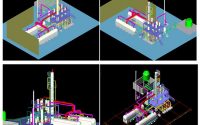Refined Olive Pomace Oil
Olive pomace is the pulpy residue from olives after pressing.
The total of olive weight, the pomace 70 – 90 %, the stone 9-27% and the seed about 2-3%.
Pomace contains about 2-8 % residual oil.
Olive pomace oils, obtained by refining of the oil extracted from the olive pomace.
The purpose of processing the remaining pulp from olive oil production is to produce edible oil.
Olive pomace should be delivered immediately to the extraction factory (on the same day it is produced) for drying in order to avoid any increases in acidity in the olive-pomace oil.
After drying, pomace extracted by hexane to yield raw olive-pomace oil
Raw olive-pomace oil must be refined to become edible.
The edible product sold as olive-pomace oil is refined olive-pomace oil
PROCESS STEPS
1)DRYING THE POMACE
2)EXTRACTION
3)DISTILLATION
4)REFINING
FLOWCHART
DRYING
Halt the fermentation of the pomace.
Carried out by blowing hot air over the pomace in a drum screen.
Lower the moisture content to around 5-6%
The hot drying gases are used at high
temperatures (400°C to 700°C).
Final temperature of finished product not more than 70–80 °C.
EXTRACTION
Preparation of the fatty pulp
Extraction with hexane
Desolventizing of the extracted pulp
Types of Extractors
Batch Extractor
Pulp placed in an upright reactor
and sprayed with the hexane.
Commonly used for extraction.
Continuous Extractor
Pulp washed with hexane.
DISTILLATION
Distillation of the oil-hexane mixture (miscella) in a distiller.
Try to remove the hexane from the oil as soon as possible at a temperature of around 100–110 oC.
The finished product to be lower than 150 ppm of hexane in oil.
WHY DOES IT NEED REFINING ?
Because ;
The crude pomace oil obtained is a high acidity (more than 3% as oleic acid)
Dark green oil (high chlorophyll content)
High waxes content
Unpleasant odor and taste.
REFINING
Degumming
Neutralization
Bleaching
Winterization
Deodorization
DEGUMMING
Achieved by hydrating the gums using 0.1% concentrated phosphoric acid
Reduction of phospholipid content.
Precipitation with acids.
To remove precipitate.
NEUTRALIZATION
The crude pomace oil obtained is a high acidity (more than 3% as oleic acid)
Removes nearly all free-fatty acid by converting them into oil-insoluble soaps.
The oil-insoluble soaps are separated by centrifuge in the batch neutralizers.
Chemical reaction with caustic soda.
Caustic soda + Acid Soap + Water
BLEACHING
Remove the unpleasant colors of the alkali neutralized pomace oil
The oil is heated to 100℃.
Stirred with the bleaching earth for 30 min under a vacuum (30-40 mmHg)
Bleached oil removed from the activated earth and charcoal by filtration.
WINTERIZATION
The elimination of any compound that might cause the final product to appear cloudy
Removes waxes and high melting triacylglycerols.
The process is based on crystallization (5–8 ℃).
Increase the size of crystals.
The crystals are separated with filtration.
DEODORIZATION
Final treatment step in the refining process.
Treatment of undesirable odours.
150 ℃ to 260 ℃.
Steam is used to better tastes and aromas
Absolute vacuum between 0.2– 0.4 mbar.
IMPORTANT ANALYSIS
1)DETERMINATION of FATTY ACID CONTENTS
2)DETERMINATION of WAXES
3)DETERMINATION of FREE FATTY ACIDS (FREE ACIDITY)
4)DETERMINATION of PEROXIDE VALUE
5)DETERMINATION of STIGMASTADIENES
6)DETERMINATION of STEROL COMPOSITION
GENERIC CHEMICAL COMPOSITION PARAMETERS


